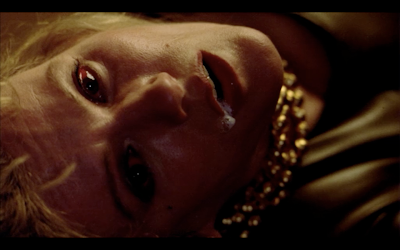A Case of the Mondays: Cindy Sherman’s Office Killer and Genre Violence
Office Killer (1997) dir. Cindy Sherman
Horror movies are an excellent example of cinematic rubbernecking. The audience strains to see the evidence of violence beyond the frame, suspense grows from knowing that something horrible is lurking, and if there’s a glimpse of the gore, it is only for a second, leaving a flash of blood or splintered bone imprinted in the audience’s mind. There is no lingering on these images, maybe because the longer the gaze is sustained it switches from shock and terror to something else, like disgust and fetishization -- it’s impolite to stare. Which makes Office Killer (1997), Cindy Sherman’s directorial experiment, an awkward intersection of these glances.
Sherman’s photographs from Untitled Film Stills (1977-1980) managed to supplant an entire film’s narrative with a single image, and her care for cinematic perspective is definitely not lacking in Office Killer. There are some soppingly gorgeous character shots, pretty when they hide something, but not suspenseful -- Sherman prefers to linger on gore, either when pulling what appears to be a food processor blade from the mailboy’s neck, or stitching up a chest-wound with packing tape. The titular mousy copyeditor, Dorine (Carol Kane), is a clownish representation of sad, sexless spinster -- cats everywhere, live-in crippled mother, lots of ‘60s knitwear, giant eye-glasses, slip always showing, and eyebrows drawn (presumably) during an earthquake. After choosing not to report the accidental killing of her boss, she begins murdering coworkers seemingly without motivation. The audience receives hints at Dorine’s psyche with a cocktailing of horror tropes, lazy Freudian stuff from the likes of Psycho and The Bad Seed, but it’s really only the materiality of the film that seems to concern Sherman. Dark stairwells, stormy nights and nervously smoking women take up a lot of screentime, as do shots of office supplies at askew angles.

The office setting doesn’t engender so much creativity within the horror tropes, but it does offer a semi-technophobic motivation for Dorine’s murders. Turns out the new manager of the office is embezzling funds by over-inflating the compensatory price of the new computers that threaten Dorine’s job. But when Dorine murders the mailboy, she enacts the next phase of technological development, making some positions and characters obsolete. That she also murders the head of the company, by placing a butane canister into her asthma inhaler, shows that she does not discriminate based on professional hierarchies -- a characteristic reinforced by the random murder of two girl scouts.
We rarely see the act of violence and more often linger on its effects -- instead of accelerating the tension towards climax and then cutting away, the film likes to wallow in the aftermath. Office Killer's horror seems to work best as an animation of photographs, easily packaged as a film but best enjoyed piece by piece, where the wallowing time is up to the viewer. As a film it explains and shows too much; as photos, you’d strain your eyes to see what is kept in suspense.



No comments:
Post a Comment